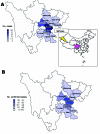Human Streptococcus suis outbreak, Sichuan, China
- PMID: 16707046
- PMCID: PMC3373052
- DOI: 10.3201/eid1206.051194
Human Streptococcus suis outbreak, Sichuan, China
Abstract
From mid-July to the end of August 2005, a total of 215 cases of human Streptococcus suis infections, 66 of which were laboratory confirmed, were reported in Sichuan, China. All infections occurred in backyard farmers who were directly exposed to infection during the slaughtering process of pigs that had died of unknown causes or been killed for food because they were ill. Sixty-one (28%) of the farmers had streptococcal toxic shock syndrome; 38 (62%) of them died. The other illnesses reported were sepsis (24%) and meningitis (48%) or both. All isolates tested positive for genes for tuf, species-specific 16S rRNA, cps2J, mrp, ef, and sly. A single strain of S. suis caused the outbreak, as shown by the identification of a single ribotype. The high death ratio was of concern; prohibiting backyard slaughtering ended the outbreak.
Figures





References
-
- Acha PN, Szyfres B. Zoonoses and communicable diseases common to man and animals. Vol 1. Bacterioses and mycoses. 3rd ed. Washington: Pan American Health Organization; 2003. p. 257–65.
-
- Higgins R, Gottschalk M. Streptococcal diseases. In: Straw BE, D'Allaire S, Mengeling WL, Taylor DJ, editors. Diseases of swine. Ames (IA):Iowa State University Press; 1999. p. 563–78.
-
- Krauss H, Weber A, Appel M, eds. Zoonoses—infectious diseases transmissible from animals to humans, 3rd ed. Washington: ASM Press; 2003. p. 239-40.
-
- Kay R, Cheng AF, Tse CY. Streptococcus suis infection in Hong Kong. QJM. 1995;88:39–47. - PubMed
MeSH terms
Substances
LinkOut - more resources
Full Text Sources
Other Literature Sources
Medical
